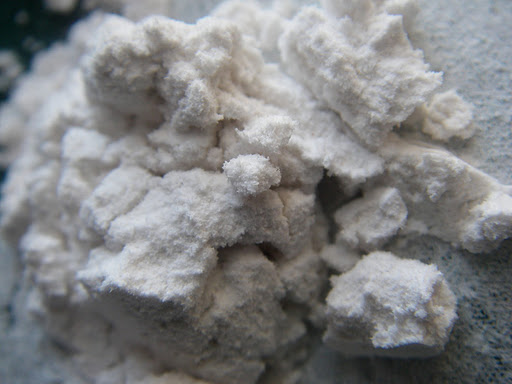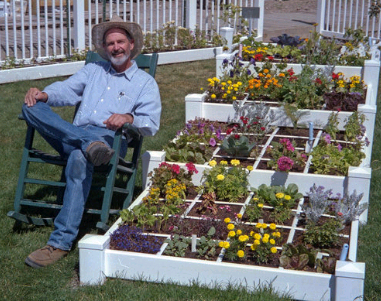
Diatomaceous Earth
Diatomaceous Earth is a natural, organic garden pest control, it is a powder made of 100-percent organic ground fossils of diatoms that came from fresh water  Diatomaceous Earth kills by physical action- not chemical. While it seems like a harmless powder to us, it is actually quite sharp and hazardous to insects. It must come in contact with the pest to be effective. It will scratch and puncture the exoskeleton of soft-bodied insects, thereby causing them to dehydrate and die.[/caption] I dust it on the plants to reduce numbers of whiteflies and aphids, I first spray the plant with organic insecticidal soap, then I dust the powder on the wet plant and it sticks for days.I didn't really know I had an aphid problem until I noticed the drying and yellowing of my out of season watermelon plant that was doing pretty well until its infestation, and one of the corn plants. I neglected the yellowing for a while until I took a closer look to find tiny clusters of aphids on the underside of leaves. I discarded the heavily infested sections of the plant and I did the soap and powder method on the okay ones. I got my powder from Amazon.com , there are many brands, you only have to make sure its food grade diatomaceous earth which is completely safe and organic. You will see a lot of this powder on my plants, now you know what it is!
Diatomaceous Earth kills by physical action- not chemical. While it seems like a harmless powder to us, it is actually quite sharp and hazardous to insects. It must come in contact with the pest to be effective. It will scratch and puncture the exoskeleton of soft-bodied insects, thereby causing them to dehydrate and die.[/caption] I dust it on the plants to reduce numbers of whiteflies and aphids, I first spray the plant with organic insecticidal soap, then I dust the powder on the wet plant and it sticks for days.I didn't really know I had an aphid problem until I noticed the drying and yellowing of my out of season watermelon plant that was doing pretty well until its infestation, and one of the corn plants. I neglected the yellowing for a while until I took a closer look to find tiny clusters of aphids on the underside of leaves. I discarded the heavily infested sections of the plant and I did the soap and powder method on the okay ones. I got my powder from Amazon.com , there are many brands, you only have to make sure its food grade diatomaceous earth which is completely safe and organic. You will see a lot of this powder on my plants, now you know what it is!
 Diatomaceous Earth kills by physical action- not chemical. While it seems like a harmless powder to us, it is actually quite sharp and hazardous to insects. It must come in contact with the pest to be effective. It will scratch and puncture the exoskeleton of soft-bodied insects, thereby causing them to dehydrate and die.[/caption] I dust it on the plants to reduce numbers of whiteflies and aphids, I first spray the plant with organic insecticidal soap, then I dust the powder on the wet plant and it sticks for days.I didn't really know I had an aphid problem until I noticed the drying and yellowing of my out of season watermelon plant that was doing pretty well until its infestation, and one of the corn plants. I neglected the yellowing for a while until I took a closer look to find tiny clusters of aphids on the underside of leaves. I discarded the heavily infested sections of the plant and I did the soap and powder method on the okay ones. I got my powder from Amazon.com , there are many brands, you only have to make sure its food grade diatomaceous earth which is completely safe and organic. You will see a lot of this powder on my plants, now you know what it is!
Diatomaceous Earth kills by physical action- not chemical. While it seems like a harmless powder to us, it is actually quite sharp and hazardous to insects. It must come in contact with the pest to be effective. It will scratch and puncture the exoskeleton of soft-bodied insects, thereby causing them to dehydrate and die.[/caption] I dust it on the plants to reduce numbers of whiteflies and aphids, I first spray the plant with organic insecticidal soap, then I dust the powder on the wet plant and it sticks for days.I didn't really know I had an aphid problem until I noticed the drying and yellowing of my out of season watermelon plant that was doing pretty well until its infestation, and one of the corn plants. I neglected the yellowing for a while until I took a closer look to find tiny clusters of aphids on the underside of leaves. I discarded the heavily infested sections of the plant and I did the soap and powder method on the okay ones. I got my powder from Amazon.com , there are many brands, you only have to make sure its food grade diatomaceous earth which is completely safe and organic. You will see a lot of this powder on my plants, now you know what it is!













 You can change the measurements how ever you like, most importantly, you have to make sure each square is 1ft squared in size= 30 cm. Also Most vegetables require 6 inches of soil, I've decided to use around 20cm. If the boxes are placed over a garden/soil, they don't need bottoms. In my case, I have to apply bottoms since they're going to be in the roof. The bottoms are waterproof 2cm thick plywood. The plywood has to have around 0.6 cm holes drilled in each square, plus in the corners. My boxes have weird squares in the plywood because the carpenter mistook 0.6cm for huge 6cm holes, I had them fix them without problems. Potato/Carrot beds:
You can change the measurements how ever you like, most importantly, you have to make sure each square is 1ft squared in size= 30 cm. Also Most vegetables require 6 inches of soil, I've decided to use around 20cm. If the boxes are placed over a garden/soil, they don't need bottoms. In my case, I have to apply bottoms since they're going to be in the roof. The bottoms are waterproof 2cm thick plywood. The plywood has to have around 0.6 cm holes drilled in each square, plus in the corners. My boxes have weird squares in the plywood because the carpenter mistook 0.6cm for huge 6cm holes, I had them fix them without problems. Potato/Carrot beds: 

